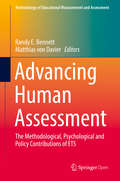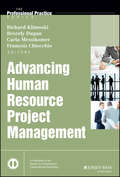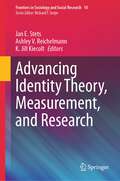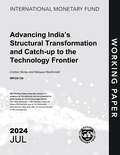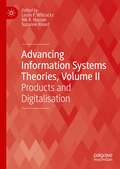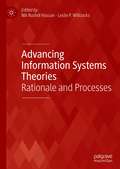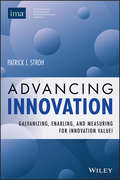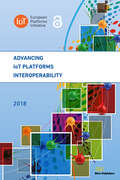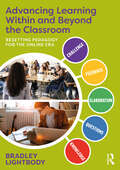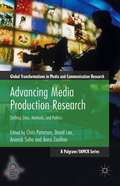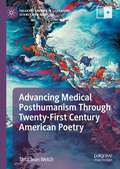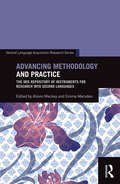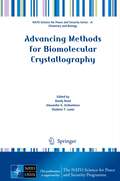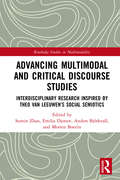- Table View
- List View
Advancing Human Assessment: The Methodological, Psychological and Policy Contributions of ETS (Methodology of Educational Measurement and Assessment)
by Matthias Von Davier Randy E. BennettThis book is open access under a CC BY-NC 2. 5 license. This book describes the extensive contributions made toward the advancement of human assessment by scientists from one of the world's leading research institutions, Educational Testing Service. The book's four major sections detail research and development in measurement and statistics, education policy analysis and evaluation, scientific psychology, and validity. Many of the developments presented have become de-facto standards in educational and psychological measurement, including in item response theory (IRT), linking and equating, differential item functioning (DIF), and educational surveys like the National Assessment of Educational Progress (NAEP), the Programme of international Student Assessment (PISA), the Progress of International Reading Literacy Study (PIRLS) and the Trends in Mathematics and Science Study (TIMSS). In addition to its comprehensive coverage of contributions to the theory and methodology of educational and psychological measurement and statistics, the book gives significant attention to ETS work in cognitive, personality, developmental, and social psychology, and to education policy analysis and program evaluation. The chapter authors are long-standing experts who provide broad coverage and thoughtful insights that build upon decades of experience in research and best practices for measurement, evaluation, scientific psychology, and education policy analysis. Opening with a chapter on the genesis of ETS and closing with a synthesis of the enormously diverse set of contributions made over its 70-year history, the book is a useful resource for all interested in the improvement of human assessment.
Advancing Human Resource Project Management
by Richard J. Klimoski Carla Messikomer Francois Chiocchio Beverly DuganGet real-world solutions and evidence-based guidelines for HRproject management challenges Tackling major human resources management projects can bedaunting, but now you can learn from the lessons of HRprofessionals who have encountered roadblocks or challenges insimilar contexts. Advancing Human Resource ProjectManagement is an in-depth, thoughtful resource that highlightsthe knowledge and experience of those who have undertaken large HRprojects. This guide illustrates what worked and what didn't, witha focus on evidence and real-world cases to illuminate effectivestrategies and solutions. Each chapter presents empirical findingscomplemented by professional judgment and wisdom from humanresource management professionals well-versed in global businessenvironments.Advancing Human Resource Project Management recognizesthe importance of context, addresses the practical and professionalimplications of managing HR management projects in differentindustry sectors, and provides comprehensive coverage onimplementing global development programs and project initiation andplanning. Ideal for global Industrial and Organizational Psychologyfaculty and practitioners, graduate students, and, especially, HRprofessionals, this resource uncovers the best evidence-basedpractices available today for effective HR project managementstrategies. The book includes:An emphasis on the implications and challenges of providingsolutions for HR business problems on a global scaleReal-world cases and firsthand professional experiences withsummaries of knowledge gained from research and practiceAdvice on tackling challenges inherent in various stages of aprojectExpertise and counsel from HR professionals familiar with largeprojects and from those who study and work in the field of projectmanagementLet this comprehensive resource guide your approach toinitiating and managing large HR projects. With solid, empiricalevidence and relatable case studies, Advancing Human ResourceProject Management is the ideal professional companion forthose looking to strengthen their project techniques, projectleadership, and management skills.
Advancing Identity Theory, Measurement, and Research (Frontiers in Sociology and Social Research #10)
by Jan E. Stets Ashley V. Reichelmann K. Jill KiecoltThis volume presents recent advances in identity theory, which is a prominent and active theory in sociological social psychology and a versatile framework for explaining the sources of identities, how they develop, how they operate in situations and groups, and how they influence behavior and well-being. The volume is organized around new theoretical developments, measurement techniques, and research in the field. Theoretical developments covered in the volume sharpen, reframe, and expand fundamental concepts in identity theory. State-of-the-art techniques for measuring identities assess, refine, and update existing measures. New research in the volume addresses both individual processes and outcomes and group processes and outcomes. The chapters together showcase the wide applicability of identity theory to a host of identities, such as the religious, gender, sexual, physical attractiveness, racial/ethnic, parent, student, partisan, and group member identities. The volume editors introduce identity theory and provide an overview of the chapters. In the last chapter, they describe how this volume points to future directions for advancing theory, measurement, and research in identity theory. This volume is of interest to a wider readership, including sociological social psychologists, sociologists, and scholars in other disciplines (psychology, political science, economics, education) whose research or teaching deals with identities. Graduate and advanced undergraduate students interested in identity research will also find this book accessible. Finally, this is for discerning laypersons who are interested in how identities influence and shape their lives and affect their well-being.
Advancing Immigrant Rights in Houston (PLAC: Political Lessons from American Cities)
by Shannon Gleeson Els de GraauwHouston is one of the most diverse cities in the United States and has long been a prime destination for international migrants from Latin America, Asia, and more recently, Africa. However, the city is politically mixed, organizationally underserved, and situated in a relatively anti-immigrant state. This makes Houston a challenging context for immigrant rights despite its rapidly diversifying population. In Advancing Immigrant Rights in Houston, Els de Graauw and Shannon Gleeson recount how local and multi-level contexts shape the creation, contestation, and implementation of immigrant rights policies and practices in the city. They examine the development of a city immigrant affairs office, interactions between local law enforcement and federal immigration enforcement officials, local public-private partnerships around federal immigration benefits, and collaborations between labor, immigrant rights, faith, and business leaders to combat wage theft. The case study of Houston provides a bellwether for how other U.S. cities will deal with their growing immigrant populations and underscores the importance of public-private collaborations to advance immigrant rights.
Advancing India’s Structural Transformation and Catch-up to the Technology Frontier (Imf Working Papers)
by MacDonaldA report from the International Monetary Fund.
Advancing Information Systems Theories, Volume II: Products and Digitalisation (Technology, Work and Globalization)
by Leslie P. Willcocks Suzanne Rivard Nik R. HassanInformation systems research (IS) is an exciting multidisciplinary area that links the rapidly changing technology of information (or communications and information technology, ICT) to the business and social environment. Lately, the discourse surrounding information and systems has leaped into the consciousness of the public in unprecedented ways through the rise of social media, the Internet of Things (IoT), 'fake news' and the weaponization of information, to name a few. Unfortunately, it has been felt that these developments are overtaking the ability of the IS field to address them, in part, because the field itself lacks its own native theories. It is well known that the IS field undertakes its research using theories from its 'reference disciplines' such as management, social psychology, economics, communication and computer science, but what this book offers is a clarification and implementation of the discipline's own foundational theory. This book is the companion volume to Advancing Information Systems Theories: Volume I, and part of a three part series that aims to advance IS research. This volume addresses the products of information systems theories, examining design principles, information, practice principles for robotics, and other concepts integral to developing theory. The book will be of interest to academics studying information systems, Big Data, digital business, information technology, innovation management, and digital management.
Advancing Information Systems Theories: Rationale and Processes (Technology, Work and Globalization)
by Leslie P. Willcocks Nik Rushdi HassanThe information systems (IS) field represents a multidisciplinary area that links the rapidly changing technology of information (or communications and information technology, ICT) to the business and social environment. Despite the potential that the IS field has to develop its own native theories to address current issues involving ICT it has consistently borrowed theories from its “reference disciplines,” often uncritically, to legitimize its research. This volume is the first of a series intended to advance IS research beyond this form of borrowed legitimization and derivative research towards fresh and original research that naturally comes from its own theories. It is inconceivable for a field so relevant to the era of the hyper-connected society, disruptive technologies, big data, social media, "fake news" and the weaponization of information to not be brimming with its own theories. The first step in reaching the goal of developing native IS theories is to reach an agreement on the need for theory (its rationale) and its role as the most distinctive product of human intellectual activity. This volume addresses what theories are, why bother with theories and the process of theorizing itself because the process of developing theories cannot be divorced from the product of that process. It will lay out a research agenda for decades to come and will be invaluable reading for any academic in the IS field and related disciplines concerned with information, systems, technology and their management.
Advancing Innovation: Galvanizing, Enabling, and Measuring for Innovation Value!
by Patrick J. StrohMaster the standards and interpretations that govern preparation, compilation, and review engagements with this authoritative resource Advancing Innovation: Galvanizing, Enabling, and Measuring for Innovation Value! provides readers with a comprehensive treatment of how to perform engagements while complying with the Statements on Standards for Accounting and Review Services (SSARS). Newly updated, Advancing Innovation delivers practical guidance for the application of the standards to readers’ specific circumstances. Written by two celebrated accountants and businesspeople, Robert S. Kaplan and Patrick Stroh, Advancing Innovation includes: Fully indexed topics arranged by subject Clarified standards that provide a framework for planning and performing an engagement that meets client needs Explanations of amendments, deleted or superseded content, and conforming changes due to the issuance of other authoritative guidance Perfect for any accountant expected to perform preparation, compilation, or review engagements, Advancing Innovation covers all SSARSs, including SSARS No. 21 through 25, the last of which further converges AR-C section 90 with ISRE 2400 (Revised).
Advancing Interdisciplinary Approaches to International Relations
by Steve A. Yetiv Patrick JamesThis edited volume breaks new ground by innovatively drawing on multiple disciplines to enhance our understanding of international relations and conflict. The expansion of knowledge across disciplines and the increasingly blurred boundaries in the real world both enable and demand thinking across intellectual borders. While multidisciplinary and interdisciplinary are prominent buzz words, remarkably few books advance them. Yet doing so can sharpen and expand our perspective on academic and real world issues and problems. This book offers the most comprehensive treatment to date and is an invaluable resource for students, scholars and practitioners.
Advancing International Human Rights Law Responsibilities of Development NGOs: Respecting and Fulfilling the Right to Reparative Justice for Genocide Survivors in Rwanda
by Noam SchimmelThis book explores the potential responsibilities to respect, protect and fulfill international human rights law (IHRL) of a particular class of non-state actors: non-governmental organizations (NGOs). It calls for NGOs pursuing development to respect and fulfill the human right of genocide survivors to reparative justice in Rwanda. It argues that NGOs have social and moral responsibilities to respect and fulfill IHRL, and for greater accountability for them to do so. The book focuses on those NGOs advancing development in a post genocide transitional justice context acting simultaneously in partnership with state governments, as proxies and agents for these governments, and providing essential public goods and social services as part of their development remit. It defines development as a process of expanding realization of social, economic, and cultural rights addressing food security, economic empowerment/poverty reduction, healthcare, housing, education, and other fundamental human needs while integrating these alongside the expansion of freedoms and protections afforded by civil and political rights. It uses post genocide Rwanda as a case study to illustrate how respect and fulfillment of the IHRL pertaining to reparative justice are hindered by failing to hold NGOs responsible for IHRL. Consequently, this results in discrimination against, marginalization, and the disadvantaging of survivors of the Rwandan genocide against the Tutsi and violations of their human rights.
Advancing IoT Platforms Interoperability
by Ovidiu VermesanThe IoT European Platforms Initiative (IoT-EPI) projects are addressing the topic of Internet of Things and Platforms for Connected Smart Objects and aim to deliver an IoT extended into a web of platforms for connected devices and objects that supports smart environments, businesses, services and persons with dynamic and adaptive configuration capabilities. The specific areas of focus of the research activities are architectures and semantic interoperability, which reliably cover multiple use cases. The goal is to deliver dynamically-configured infrastructure and integration platforms for connected smart objects covering multiple technologies and multiple intelligent artefacts. The IoT-EPI ecosystem has been created with the objective of increasing the impact of the IoT-related European research and innovation, including seven European promising projects on IoT platforms: AGILE, BIG IoT, INTER-IoT, VICINITY, SymbIoTe, bIoTope, and TagItSmart.This white paper provides an insight regarding interoperability in the IoT platforms and ecosystems created and used by IoT-EPI. The scope of this document covers the interoperability aspects, challenges and approaches that cope with interoperability in the current existing IoT platforms and presents some insights regarding the future of interoperability in this context. It presents possible solutions, and a possible IoT interoperability platform architecture.
Advancing Islāmic Psychology Education: Knowledge Integration, Model, and Application (Islamic Psychology and Psychotherapy)
by G. Hussein RassoolThis book provides academic and clinical institutions for developing their educational programmes in psychology, psychotherapy, and counselling from an Islāmic paradigm. Examining the educational approach in the decolonisation of psychology curricula, the book proposes a vertically and horizontally integrated, embedded curriculum model. This model meets the changing needs of practitioners, incorporating indigenous cultural aspects and emerging technologies to reflect new and creative ways of thinking about delivering education in the post Covid-19 era. The chapters also demonstrate how curriculum development, based on the principles of Islamic education, helps institutions to establish purpose, define activities, and guide decision making in educational development. A series of steps for implementing this need-driven educational programme has been suggested. This practical, concise, and evidenced-based text will be a key resource for educators and trainers. It will help them understand how to re-design or suggest changes to curriculum structure, shape, and content in Islāmic psychology, psychotherapy, and counselling for undergraduate, postgraduate and continuing professional development levels of education.
Advancing Land Change Modeling: Opportunities and Research Requirements
by Committee on Needs Research Requirements for Land Change ModelingPeople are constantly changing the land surface through construction, agriculture, energy production, and other activities. Changes both in how land is used by people (land use) and in the vegetation, rock, buildings, and other physical material that cover the Earth's surface (land cover) can be described and future land change can be projected using land-change models (LCMs). LCMs are a key means for understanding how humans are reshaping the Earth's surface in the past and present, for forecasting future landscape conditions, and for developing policies to manage our use of resources and the environment at scales ranging from an individual parcel of land in a city to vast expanses of forests around the world. "Advancing Land Change Modeling: Opportunities and Research Requirements" describes various LCM approaches, suggests guidance for their appropriate application, and makes recommendations to improve the integration of observation strategies into the models. This report provides a summary and evaluation of several modeling approaches, and their theoretical and empirical underpinnings, relative to complex land-change dynamics and processes, and identifies several opportunities for further advancing the science, data, and cyberinfrastructure involved in the LCM enterprise. Because of the numerous models available, the report focuses on describing the categories of approaches used along with selected examples, rather than providing a review of specific models. Additionally, because all modeling approaches have relative strengths and weaknesses, the report compares these relative to different purposes. "Advancing Land Change Modeling's" recommendations for assessment of future data and research needs will enable model outputs to better assist the science, policy, and decisionsupport communities.
Advancing Leadership Theory and Practice
by Nitin Nohria Rakesh KhuranaMore than a means of getting ahead and gaining power, leadership must be understood as a serious professional and personal responsibility. In this introductory chapter, editors Nitin Nohria, the dean of Harvard Business School, and Rakesh Khurana, a professor of leadership development at HBS, point out that while many university graduate programs in business, law, education, and public policy claim that their mission is to educate leaders who will advance the well-being of society, the reality is that scholarly research on leadership is, at best, at the periphery of these same universities. In fact, the increasing demand for insights about leadership has largely been met by popular writers-consultants, journalists, or "iconic" business leaders. The papers that comprise this book-originally presented at the Harvard Business School Centennial Colloquium, "Leadership: Advancing an Intellectual Discipline"-are a starting point. Nohria and Khurana define five dualities that they believe are at the heart of research on leadership-for example, the duality between the leader's role in producing superior results and the leader's role in creating meaning. The chapter concludes with a brief summary of each of the book's 25 subsequent chapters. This chapter was originally published as Chapter 1 of "Handbook of Leadership Theory and Practice: A Harvard Business School Centennial Colloquium."
Advancing Learning Within and Beyond the Classroom: Resetting Pedagogy for the Online Era
by Bradley LightbodyThis insightful book sets out five core elements of good practice that will lead to great teaching and learning both within and beyond the classroom. It looks in detail at the learning process and how teachers can support this through a rich mix of teacher-led direct instruction and collaborative and online learning, both flipped and blended. Covering five major themes to reset our pedagogy, Advancing Learning Within and Beyond the Classroom presents the key evidence about ‘what works’ alongside practical activities to adopt or adapt to enhance your own practice. The chapters cover: the application of precise curricular knowledge the presentation of key questions to guide, check and deepen learning elaboration to build deep understanding personalised feedback to accelerate progress the introduction of regular challenges to drive high learning outcomes and relevant commercial and world-class standards Including a comprehensive overview of evidence-based practice and a wealth of practical strategies to drive engagement and productive learning, this is essential reading for all teachers working in secondary schools or further education.
Advancing Maternal Health Equity and Reducing Maternal Morbidity and Mortality: Proceedings of a Workshop
by Board on Population Health and Public Health Practice National Academies of Sciences, Engineering, and Medicine Health and Medicine DivisionThe United States faces an alarmingly high rate of maternal morbidity and mortality, distinguishing it from other high-income countries that have achieved decreases in these rates in recent years. U.S. maternal morbidity and mortality rates are disproportionate across racial, ethnic, socioeconomic, and geographic groups. Statistics on maternal health outcomes reveal that there are challenges to protecting both the lives and future health of birthing people and their children. Recognizing the urgency of this growing problem, the National Academies Board on Population Health and Public Health Practice convened a 2-day virtual workshop, Advancing Maternal Health Equity and Reducing Maternal Mortality. The workshop examined the current state of maternal health in the United States and explored the factors needed to help communities and health care systems become more effective in reducing maternal morbidity and mortality and improving health outcomes through the fourth trimester. This publication summarizes the presentations and discussions of the workshop.
Advancing Media Production Research: Shifting Sites, Methods, And Politics (Global Transformations In Media And Communication Research - A Palgrave And Iamcr Ser.)
by David Lee Chris Paterson Anamik Saha Anna ZoellnerThis anthology explores challenges to understanding the nature of cultural production, exploring innovative new research approaches and improvements to old approaches, such as newsroom ethnography, which will enable clearer, fuller understanding of the workings of journalism and other forms of media and cultural production.
Advancing Medical Posthumanism Through Twenty-First Century American Poetry (Palgrave Studies in Literature, Science and Medicine)
by Tana Jean WelchAdvancing Medical Posthumanism Through Twenty-First Century American Poetry places contemporary poetics in dialogue with posthumanism and biomedicine in order to create a framework for advancing a posthuman-affirmative ethics within the culture of medical practice. This book makes a case for a posthumanist understanding of the body—one that sees health and illness not as properties possessed by individual bodies, but as processes that connect bodies to their social and natural environment, shaping their capacity to act, think, and feel. Tana Jean Welch demonstrates how contemporary American poetry is specifically poised to develop a pathway toward a posthuman intervention in biomedicine, the field of medical humanities, medical discourse, and the value systems that guide U.S. healthcare in general.
Advancing Medicine with Food and Nutrients
by Ingrid KohlstadtFood and nutrients are the original medicine and the shoulders on which modern medicine stands. But in recent decades, food and medicine have taken divergent paths and the natural healing properties of food have been diminished in the wake of modern technical progress. With contributions from highly regarded experts who work on the frontlines of disease management, the bestselling first edition of Advancing Medicine with Food and Nutrients, Food and Nutrients in Disease Management effectively brought food back into the clinical arena, helping physicians put food and nutrients back on the prescription pad.Board-certified in General Preventive Medicine, Ingrid Kohlstadt, MD, MPH has been elected a Fellow of the American College of Nutrition and a Fellow of the American College of Preventive Medicine. Guided by Dr. Kohlstadt, this authoritative reference equips clinicians with the information they need to fully utilize nutritional medicine in their practice. New in the Second Edition Toxic exposures such as molds, microbial infections, xenoestrogens, heavy metals, and inert nanoparticles Food safety issues: precautions for patients with preexisting medical conditions, adequate labeling of food allergens such as gluten, potential adverse effects of artificial sweeteners, consequences of applying ionizing radiation to food, food-borne mycotoxins, critical food restrictions following bariatric surgery, precautions for preparing food in the home Consumer advocacy issues on navigating claims of medical foods and dietary supplements Physical forces on nutritional needs, such as ultraviolet light initiating vitamin D synthesis, non-ionizing radiation’s effects on brain glucose metabolism and excess body fat’s effects on inflammation and hydration Preventive medicine and how to preserve resiliency at the individual and public health levels Written by doctors for doctors, Advancing Medicine with Food and Nutrients, Second Edition reunites food and medicine. Buttressed with new evidence, leading physicians on the frontlines of disease management apply the latest scientific advances to the clinical practice of medicine. Each chapter offers adjuncts to standard care, fewer side effects, improved risk reduction, or added quality of life.An article by Ingrid Kohlstadt on education and nutrition appeared in TIME Magazine online on November 12, 2014.
Advancing Methodology and Practice: The IRIS Repository of Instruments for Research into Second Languages (Second Language Acquisition Research Series)
by Alison Mackey Emma MarsdenInstruments for Research into Second Languages is an accessible introduction to understanding and evaluating existing and emerging methodologies in L2 research. The book provides an introduction to the data collection materials available in the IRIS database. IRIS is an open access, searchable repository of instruments used to elicit data for research into second and foreign language learning and teaching. The book is aimed at graduate students, researchers and educators in the fields of Applied Linguistics and Second Language Acquisition. Featuring contributions from top scholars in the field, this dynamic volume includes empirical research carried out using innovative instruments held in IRIS, offering insights into their basic mechanics, how and why they are used, as well as the challenges they can present. The chapters describe the kinds of data (evidence about knowledge, processing, interaction, learning, and motivation) that result from these methods, and they discuss conditions that lead to reliable and valid data collection and analysis. This unique collection provides researchers, professionals, and students with up-to-date responses to practical and theoretical questions about how second language learning and teaching can be investigated using the IRIS database of instruments. IRIS was funded by the Economic and Social Research Council and is a long term British Academy Research Project.
Advancing Methods for Biomolecular Crystallography (NATO Science for Peace and Security Series A: Chemistry and Biology)
by Alexandre G. Urzhumtsev Randy Read Vladimir Y. LuninThis work presents a snapshot of the state of the art of modern biomolecular crystallography, from crystallisation through structure determination and even interactive presentation on the web. Methods driving the latest automated structure determination pipelines are explained, as well as how to deal with problems such as crystal pathologies that still demand expert analysis. These methods are illustrated through their application to problems of great biological interest, such as the molecular machinery underlying the complement pathway, the mechanism of action of monoamine oxidase inhibitors, and the structure of the eukaryotic ribosome. Complementary approaches, such as neutron diffraction, small angle X-ray scattering, coherent diffraction and computational modelling, are also explored.
Advancing Multicultural Dialogues in Education
by Richard RaceThis edited collection advances the call for continued multicultural dialogues within education. Dialogue and education are the two most essential tools that can help tackle some of the biggest problems we are facing across the globe, including fanaticism, chauvinistic nationalism, religious fundamentalism and racism. The contributors to this book explore the necessity of sustained dialogue within the wider social and political sciences alongside in national and international politics, where more multicultural voices need to be heard in order to make progress. The book builds on existing evidence and literature to advocate in favour of this movement, and highlights how important and significant multiculturalism and multicultural education remains. It will be essential reading for students and academics working in the fields of education and sociology, particularly those with an interest in social justice and multiculturalism.
Advancing Multimodal and Critical Discourse Studies: Interdisciplinary Research Inspired by Theo Van Leeuwen’s Social Semiotics (Routledge Studies in Multimodality)
by Sumin Zhao Emilia Djonov Anders Björkvall Morten BoeriisAs a founder and leading figure in multimodality and social semiotics, Theo van Leuween has made significant contributions to a variety of research fields, including discourse analysis, sociolinguistics, communication and media studies, education, and design. In celebration of his illustrious research career, this volume brings together a group of leading and emerging scholars in these fields to review, explore and advance two central research agendas set out by van Leeuwen: the categorisation of the meaning potential of various semiotic resources and the examination of their uses in different forms of communication, and the critical analysis of the interaction between semiotic forms, norms and technology in discursive practices. Through 11 cutting-edge research papers and an experimental visual essay, the book investigates a broad range of semiotic resources including touch, sound, image, texture, and discursive practices such as community currency, fitness regime, film scoring, and commodity upcycling. The book showcases how social semiotics and multimodality can provide insights into the burning issues of the day, such as global neoliberalism, terrorism, consumerism, and immigration.
Advancing Music Education in Northern Europe
by David G. Hebert Torunn Bakken HaugeAdvancing Music Education in Northern Europe tells the story of a unique organization that has contributed in profound ways to the professional development of music teachers in the Nordic and Baltic nations. At the same time, the book offers reflections on how music education and approaches to the training of music teachers have changed across recent decades, a period of significant innovations. In a time where international partnerships appear to be threatened by a recent resurgence in protectionism and nationalism, this book also more generally demonstrates the value of formalized international cooperation in the sphere of higher education. The setting for the discussion, Northern Europe, is a region arguably of great importance to music education for a number of reasons, seen, for instance, in Norway’s ranking as the “happiest nation on earth”, the well-known success of Finland’s schools in international-comparative measures of student achievement, how Sweden has grappled with its recent experience as “Europe’s top recipient of asylum seekers per capita”, and Estonia’s national identity as a country born from a “Singing Revolution”, to name but a few examples. The contributors chronicle how the Nordic Network for Music Education (NNME) was founded and developed, document its impact, and demonstrate how the eight nations involved in this network – Norway, Iceland, Denmark, Sweden, Finland, Estonia, Latvia, and Lithuania – are making unique contributions of global significance to the field of music education.
